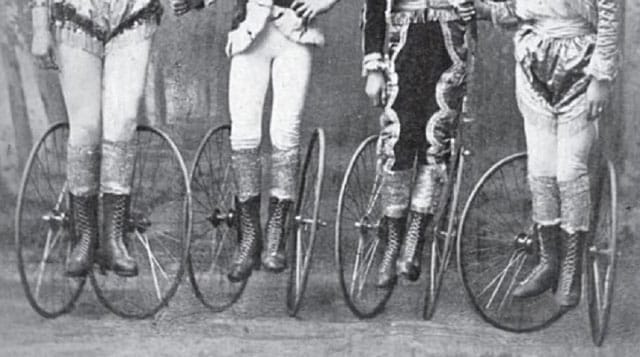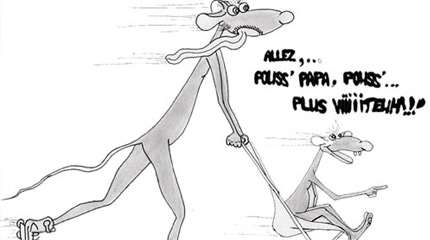Training to prepare a skating marathon
Skating is a means of transport fora lot of people. But it is also a full sporting activity with lots of popular competitions, especially marathons. That type of event attracts a great number of skaters. However, you cannot skate a marathon just like that…
Par alfathor
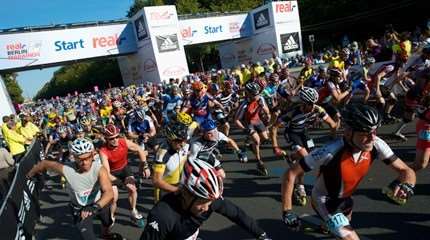
How to be ready on D-Day? here is our Training skating marathon
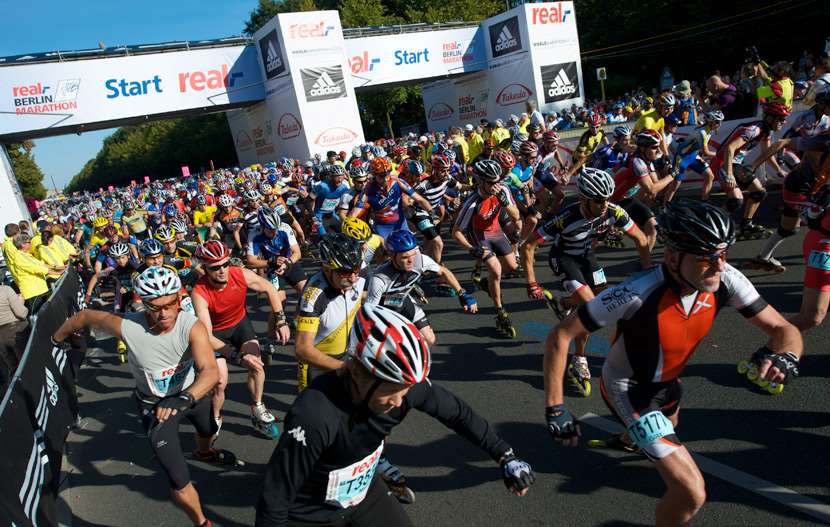
When you start enjoying skating, you quickly want to skate faster and longer. You start by training on car parks, then on the local cycle lanes, and you quickly learn the existence of skating races. The want of jumping in becomes more and more present and you end up by registering. Here are a couple of tips to prepare in the best conditions…
Training skating marathon: Improving your technique
At first, it is important not to go too fast: Skating is a technical sport. Thus, you first have to learn to skate well before trying to skate fast. If you get bad habits, you will have a hard time kicking them.
In order to skate for a long time, you have to skate efficiently. Thus, you will spend less energy and cover more distance.
Choosing the good equipment
According to you level, there are two options:
- Comfortable skates half-way between speed and fitness types with a comfortable liner and a frame equipped with wheels of big diameter
- Speed skating skates
Long distance speed/fitness skates
Long distance skates are an excellent transition towards speed skating. Their high-cut liner offers a great comfort which enables to skate several hours in a row. They are completed with a long frame with big diameter wheels, which improves the inertia and the rolling of the skate. So that with a bit of technique, you skate faster and longer without tiring yourself out.
Count on a budget of 200 to 400€ according to the brands and models.
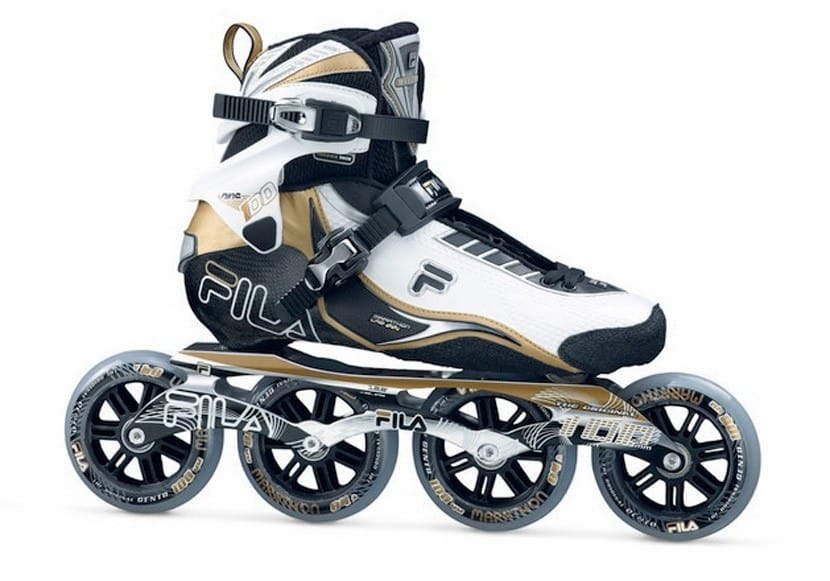
Speed skates
If you aim at performance, you need a low-cut speed skate made of glass fiber and carbon composite. The skate is equipped with a frame with 4 wheels of big diameter (100 to 110 mm).
Enthusiasts with comfortable budgets can buy themselves carbon boots, or even made to measure skates.
Warning: before buying speed-type low-cut skates, you should already have a good technical mastering of your skates.
Having a low-cut boot needs a strong and tonic ankle. You need several weeks to adapt, even several months given your level so that you get used to speed-type skates. Do not buy a new pair the day before a race!
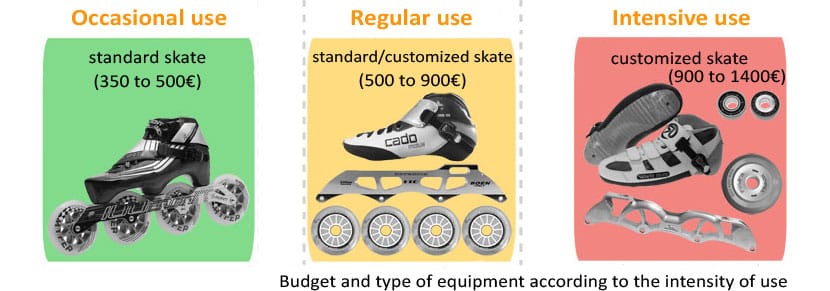
Start with shorter distances
We would advise you to start races with leisure competitions of 20 kilometers. That would enable you to get your bearings in skating with people of very heterogeneous levels. You have to handle lines, not disturb packs passing you at full speed, count your laps, learn how to hydrate during effort.
Getting used to the pack technique
It is not necessary to learn to skate in a pack, but if you start to reach a certain level, you will want to pace yourself in tailing the other skaters in front of you…
Take time to skate with the people around you. That is why it is nice to have a club nearby.
Legal conditions to take part in a race
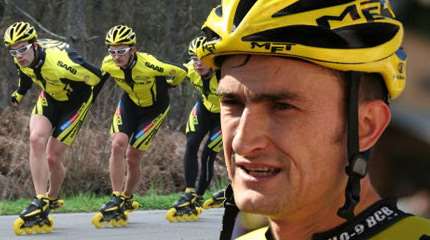
A medical certificate is required by law to take part in any timed sport events. Then, you will need a medical certificate or a sport license when you register for a race.
Training program structure by Arnaud Giquel
(World Champion and responsible for the French Center in Nantes)
In order to guide you in your preparation, here is an example of a typical preparation program.
It is divided into 3 cycles of 5 weeks.
Inside each cycle, you will find 4 micro-cycles of work and 1 micro-cycle off.
One micro-cycle is one week.
Each micro-cycle is divided into 5 days of work and two days off.
Have a good preparation!
Example of training plan
Week 1
| Day | Training | Intensity | Recovery |
| Monday | 2 x 20′ Constant pace |
+ | 10′ |
| Tuesday | 4 x 10′ | ++ | 3′ |
| Wednesday | REST | – | – |
| Thursday | 40′ Constant pace |
+ | – |
| Friday | 7 x 5′ | +++ | 2′ |
| Saturday | 1h Bike |
+ | – |
| Sunday | REST | – | – |
Week 2
| Day | Training | Intensity | Recovery |
| Monday | 2 x 10′ Constant pace |
+ | 5′ |
| Tuesday | 5 x 10′ | ++ | 3′ |
| Wednesday | REST | – | – |
| Thursday | 45′ Constant pace |
+ | – |
| Friday | 7 x 5′ | +++ | 2′ |
| Saturday | 1h30 Bike |
+ | – |
| Sunday | REST | – | – |
Week 3
| Day | Training | Intensity | Recovery |
| Monday | 3 x 15′ Constant pace |
+ | 1′ |
| Tuesday | 35′ Interval training 3′ fast/ 2′ slow |
++ / + / ++ / + | 3′ |
| Wednesday | REST | – | – |
| Thursday | 40′ 15s acceleration every 10′ |
+ / +++ | – |
| Friday | 1h bike | + | – |
| Saturday | 50′ Constant pace |
+ | – |
| Sunday | REST | – | – |
Week 4
| Day | Training | Intensity | Recovery |
| Monday | 4 x 15′ Constant pace |
+ | 1′ |
| Tuesday | 40′ Interval training 3′ fast / 2′ slow |
++ / + / ++ / + | 3′ |
| Wednesday | REST | – | – |
| Thursday | 50′ 10s acceleration every 10′ |
+ / +++ | – |
| Friday | 1h bike | + | – |
| Saturday | 1h Constant pace |
+ | – |
| Sunday | REST | – | – |
Week 6
| Day | Training | Intensity | Recovery |
| Monday | REST | – | – |
| Tuesday | 2 x 15 mn | + | 3′ |
| Wednesday | REST | – | – |
| Thursday | 40′ | + | – |
| Friday | REST | – | – |
| Saturday | 1h30 bike | + | – |
| Sunday | REST | – | – |
Week 7
| Day | Training | Intensity | Recovery |
| Monday | 1h Constant pace |
+ | – |
| Tuesday | 40′ Interval training 2′ fast / 2′ slow |
++ / + / ++ / + | – |
| Wednesday | 5 x 10′ progressive acceleration on the 3rd and 4th repetitions |
+ / ++ | 3′ |
| Thursday | 40′ | + | – |
| Friday | 3 x 16′ Constant pace |
+ | 3′ |
| Saturday | 1h bike | + | – |
| Sunday | REST | – | – |
Week 8
| Day | Training | Intensity | Recovery |
| Monday | 1h Constant pace |
+ | – |
| Tuesday | 50′ Interval training 2′ fast /3′ slow |
++ / + / ++ / + | – |
| Wednesday | 6 x 8′ Constant pace |
– | 2′ |
| Thursday | 4 x 15′ Constant pace |
+ | 5′ |
| Friday | 1h à Constant pace | + | – |
| Saturday | 1h30 bike | + | – |
| Sunday | REST | – | – |
Week 9
| Day | Training | Intensity | Recovery |
| Monday | 1h Interval training 2′ fast /2′ slow |
+ / ++ / + / ++ | – |
| Tuesday | 6 x 10′ Interval training 10′ fast / 10′ slow |
++ / + / ++ / + | – |
| Wednesday | 1 h 30 Constant pace |
+ | – |
| Thursday | 7 x 5′ | + / +++ | – |
| Friday | 1h Constant pace |
+ | – |
| Saturday | 2h00 bike | + | – |
| Sunday | REST | – | – |
Week 10
| Day | Training | Intensity | Recovery |
| Monday | 50′ Interval training 2′ fast /2′ slow |
+ / ++ / + / ++ | – |
| Tuesday | 6 x 10′ Interval training 10′ fast / 10′ slow |
++ / + / ++ / + | – |
| Wednesday | 1h30 Constant pace |
+ | – |
| Thursday | 5 x 7′ | + / +++ | – |
| Friday | 1h Constant pace |
+ | – |
| Saturday | 1h30 bike | + | – |
| Sunday | REST | – | – |
Week 11
| Day | Training | Intensity | Recovery |
| Monday | REST | – | – |
| Tuesday | 1h Constant pace |
+ | – |
| Wednesday | REST | – | – |
| Thursday | 3 x 10′ Constant pace |
+ | 3′ |
| Friday | REST | – | – |
| Saturday | REST | – | – |
| Sunday | REST | – | – |
Week 12
| Day | Training | Intensity | Recovery |
| Monday | 1h Constant pace 15s acceleration every 10′ |
+ / +++ | – |
| Tuesday | 6 x 5′ steady pace |
++ | 3′ |
| Wednesday | 1h Bike |
+ | – |
| Thursday | 3 x 20′ Constant pace |
+ | 4′ |
| Friday | 40′ Interval training 3′ steady pace 3′ recovery |
+ / ++ / + / ++ / .. | – |
| Saturday | 1h30 Bike |
+ | – |
| Sunday | REST | – | – |
Week 13
| Day | Training | Intensity | Recovery |
| Monday | 1 h Constant pace 10s acceleration every 5′ |
+ / +++ | – |
| Tuesday | 8 x 4′ Steady pace |
++ | 3′ |
| Wednesday | 1h Bike |
+ | – |
| Thursday | 4 x 15′ Constant pace |
+ | 4′ |
| Friday | 40′ Interval training 2′ steady pace 2′ recovery |
+ / ++ / + / ++ / .. | – |
| Saturday | 1h30 Bike |
+ | – |
| Sunday | REST | – | – |
Week 14
| Day | Training | Intensity | Recovery |
| Monday | 50′ Constant pace 10s acceleration every 3′ |
+ / +++ | – |
| Tuesday | 8 x 4′ Steady pace |
++ | 2′ |
| Wednesday | 1h Bike |
+ | – |
| Thursday | 5 x 10′ Constant pace |
+ | 2′ |
| Friday | 40′ Interval training 1′ steady pace 1′ recovery |
+ / ++ / + / ++ / .. | – |
| Saturday | 1h30 Bike |
+ | – |
| Sunday | REST | – | – |
Week 15
| Day | Training | Intensity | Recovery |
| Monday | 50′ Constant pace Speed up 10s every 3′ |
+ / +++ | – |
| Tuesday | 10 x 3′ steady pace |
++ | 3′ |
| Wednesday | 1h15 Bike |
+ | – |
| Thursday | 6 x 10′ Constant pace |
+ | 2′ |
| Friday | 2 x 20′ Interval training 1′ steady pace 1′ recovery. |
+ / ++ / + / ++ / .. | 5′ |
| Saturday | 1h30 Bike |
+ | – |
| Sunday | REST | – | – |
Week 16
| Day | Training | Intensity | Recovery |
| Monday | 40′ Constant pace Speed up 5s every 5′ |
+ / +++ | – |
| Tuesday | 2 x 20′ Constant pace |
++ | 5′ |
| Wednesday | REST | – | – |
| Thursday | 30′ Constant pace |
++ | – |
| Friday | REST | – | 5′ |
| Saturday | REST | + | – |
| Sunday | MARATHON | – | – |
Links
How to choose skates when you are a speed-skating beginner?
How to choose your long rides roller-skates
By Alfathor
Training plan: Arnaud Gicquel
Translated by Chloé Seyres
Photos: Berlin Roller Marathon, Fila, Salomon, ReL, all rights reserved

